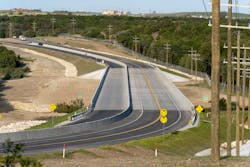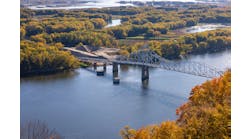There are 10 large creeks and countless smaller creeks flowing through Fort Hood’s sprawling 218,823-acre footprint.
Fort Hood is the Army’s largest active-duty armored post in the United States Armed Forces. Seven paved roads and 29 unpaved military vehicle trails, or tank trails, cross these creeks at low water crossings.
During periods of heavy rainfall, the roadway becomes dangerous, and it puts soldiers and civilians at risk of drowning. On April 11, 2017, flash flood waters washed a private vehicle off Turkey Run Road and into Clear Creek after severe weather dumped 8 inches of rain on Fort Hood over a day and a half. During a search operation, a diver from an area police department sustained injuries. Both the motorist and diver died because of the incident.
A year earlier, powerful currents overtopped a midwater crossing on Fort Hood, sweeping an Army Light Medium Tactical Vehicle into Owl Creek, overturning, and submerging it in seven feet of water, and killing nine of the 12 Soldiers on board.
The Fort Hood Turkey Run Bridge Design-Build Project (FHTRB DB Project) replaced a very dangerous low water crossing with a combination civilian, commercial, and military vehicle bridge over Clear Creek.
“The purpose and need for the project was well known among project team members and it absolutely affected our collective mindsets,” said Jason Schuetze, operations manager—Belton, James Construction Group. “We send our soldiers into harm’s way in foreign countries. When we bring them home, I think we all feel a duty to provide them and their families with a safe place to live, work and train. As a highway contractor, building public roads and bridges for the general public is what we do and it’s fairly routine for us. Building this bridge together with our Fort Hood partners was uniquely rewarding.”
However, the project had its challenges. The first obstacle was the Migratory Bird Treaty Act (MBTA), which required a five-month long tree clearing moratorium. This took effect three and a half months after the notice to proceed.
In a design-build delivery project, construction typically cannot begin during the first five-to-six months while a design package is developed and approved to perform early work. So, the first challenge was to cut the initial waiting period in half and avoid a potential 5-month MBTA delay impact to the project schedule.
No construction activities could begin without contractor generated and owner approved preparatory documents that included an Environmental Protection Plan, an Accident Prevention Plan, a Construction Quality Control Plan, a Design Quality Control Plan, and the early work, tree clearing design package. Each document had to undergo an iterative submittal and review process with each iteration subject to a contractual three-week owner review.
A now infamous winter snowstorm hit central Texas in February 2021, ahead of the March tree clearing moratorium. Subfreezing temperatures caused weeklong power outages to off-post offices and homes, interrupting the design review process.
It seemed nearly impossible to get a design package prepared and approved, and then perform and complete the clearing work ahead of the moratorium. However, the United States Army Corps of Engineers (USACE) and Fort Hood staff collaborated in devising a plan to resolve this challenge.
First, USACE offered a fast-track approach that streamlined the review and approval process by removing one full iteration from the submittal cycle. Second, USACE and Fort Hood committed to returning their review comments in days instead of weeks.
Third, USACE and Fort Hood provided helpful advice and sample documents to both reduce the effort and time needed to prepare submittals and minimize document review comments.
Fourth, USACE scheduled comment review conferences just two days after return of submittals to further expedite the approval process. The design package was approved for construction on Jan. 30, 2021, and the clearing operation was completed on March 11, just four days before the MBTA tree removal moratorium was to take effect.
“I believe each participant, without exception, made a commitment to the project and to each other, to do the right things,” Schuetze said.
The finished project provides a safer, more reliable means of connectivity between the Fort Hood Cantonment area, Fort Hood Family Housing residents, and the city of Copperas Cove, Texas, where soldiers and civilians commute to and from the post. R&B
Project: Fort Hood Turkey Run Bridge Design-Build Project
Location: Fort Hood, Texas
Owners: Department of the Army, Fort Worth District, Corps of Engineers (USACE) on behalf of Fort Hood Directorate of Public Works (Fort Hood DPW); collectively, the GOVT
Designer: S & B Infrastructure, Ltd.
Contractor: S&BI Infrastructure, Ltd; Mendez Engineering; Creacom; Texas Materials; Beaird Drilling; AK Fuquay; Rock Engineering & Testing Laboratory; RODS Surveying; James Construction Group, LLC
Cost: $13,256,532
Length: 0.51 miles
Completion Date: Aug. 26, 2022



